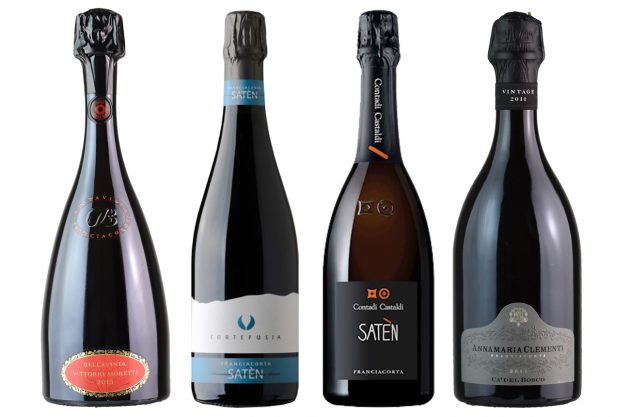When the rules were being drawn up for the production of Franciacorta, the focus was solely on the region of origin. Not the distinguishing bottle-fermented fermentation method, nor the grape varieties, nor the individual villages. Just Franciacorta, which is the producers’ ultimate identity.
Innovation has always been part of the wine producer make-up in this dynamic region of Italy, just outside Brescia and not far from Milan in the west and Verona in the east. After all, this is Italy’s economic powerhouse.
So one should not be surprised at projects that might include pioneering machinery on the one hand and scrupulous examination of the soil on the other.

Credit: Franciacorta
The move towards organic farming
Another focus for quality development is the soil, which was recently examined in a four-year project running from 2014–2018.
One hundred soil samples were analysed and environmental characteristics, such as chemical composition, soil moisture and temperature, and soil management were analysed for each soil sample. The results have confirmed the push towards the conversion to organic farming in the region. It is no accident that nearly 70% of the estates are now organic or in the process of converting to organic production.
‘In these past 30 years we have reaped important rewards, the result of courageous and sometimes unorthodox decisions,’ says Silvano Brescianini, President of the Franciacorta Consortium.
‘Now is not the time to change course: we must defend what we have achieved and use the reserves of tenacity that we are rightly famous for. In difficult times, one must invest in retaining one’s leadership position, and that is why we are working to make this a year full of activities and events, to convey a message of recovery to all our clients. Ongoing quality improvement, sustainability and internationalisation are our goals for the future.’
Retaining a leadership position
Exports account for a relatively low 10.9% of overall sales, totalling 1,700,000 bottles sold in 2020, proving the great affection of the Italian market for this sparkling wine.
Foreign sales go principally to Switzerland, Japan, Germany, USA, Belgium and Norway, in that order.
2020 was a difficult year. Celebrations had been planned for the 30th anniversary of the Consortium, and the new headquarters was ready for official opening. Then events intervened. But sales were up in the supermarket channel by a remarkable 17% against 2019, with 33% of the brands represented.
Whatever the reality, what’s certain is that Franciacorta is a dynamic appellation with a significant appetite for innovation, now focusing on expanding international sales.
Franciacorta wines to try:

Wines tasted and rated by Decanter contributor Aldo Fiordelli
Bellavista, Vittorio Moretti Millesimato Riserva, 2013 12.5%
Bellavista wines in Franciacorta have characteristic tones of honey. The Vittorio Moretti cuvée has a notable complexity too, with well balanced layers of vibrant, peachy stone fruit combined with deft oak-ageing to produce elegant violet perfumes and a buttery finish. Zesty acidity accompanies the fine and persistent mousse all the way to a ripe-fruit finish. 90
Corte Fusia, Satèn Millesimato Riserva, 2014 12.5%
Two talented friends make Franciacorta on this youthful estate with vineyards located high on Monte Orfano. The incoming 2014 vintage (not Satèn) will be excellent, but it’s not ready yet. Meanwhile this Satèn is bright and intense with apple pie and toasted cheese aromas, funky notes such as mushrooms, and vibrant white peach and mango flavours. A high, zesty acidity blends with the fruit and precedes an excellent finish, all enhanced by a fine silky mousse. 92
Contadi Castaldi, Satèn Millesimato, 2017 12.5%
Contadi Castaldi makes what is probably the flagship example of Satèn in Franciacorta. Bright in the glass, with white flowers, lime and broom on the nose, it’s polished and feminine, with graceful citrus aromas. Fruitiness contributes to an overarching freshness and the delicate velvety palate precedes a lemony finish with body enough to give it complexity. 91
Ca’ del Bosco, Anna Maria Clementi Riserva, 2011 12.9%
Anna Maria Clementi is instantly identifiable in a blind tasting because of its pure and well-defined fruit. Pineapple and peachy flavours predominate. On the nose, yeastiness enhances the aromatic profile, with brioche character and nutty tones, even if the yellow and slightly tropical fruit dominates its citrus flavours. This is a typical example of the cuvée in which fruit makes the balance between acidity and creaminess opulent. 90
Berlucchi, Guido Il Nature 61 Rosé Millesimato, 2011 12.5%
The 2011 vintage is one of the most celebrated in Franciacorta and now, 10 years later, after a long sur lie maturation, the concentration and complexity of the wines are at their best. This zero dosage rosé has a pale salmon colour in the glass, with minerality and strawberry fruit enhanced by aromas of violets and dried figs. Fine, fragrant mousse and lifted, long acidity. 93
More on Franciacorta:
Franciacorta: understanding the territory
Franciacorta: modernity with history
Franciacorta: sustainability is more than a trend









